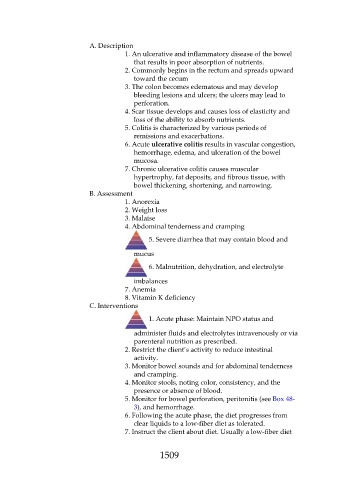Page 1509 - Saunders Comprehensive Review For NCLEX-RN
P. 1509
A. Description
1. An ulcerative and inflammatory disease of the bowel
that results in poor absorption of nutrients.
2. Commonly begins in the rectum and spreads upward
toward the cecum
3. The colon becomes edematous and may develop
bleeding lesions and ulcers; the ulcers may lead to
perforation.
4. Scar tissue develops and causes loss of elasticity and
loss of the ability to absorb nutrients.
5. Colitis is characterized by various periods of
remissions and exacerbations.
6. Acute ulcerative colitis results in vascular congestion,
hemorrhage, edema, and ulceration of the bowel
mucosa.
7. Chronic ulcerative colitis causes muscular
hypertrophy, fat deposits, and fibrous tissue, with
bowel thickening, shortening, and narrowing.
B. Assessment
1. Anorexia
2. Weight loss
3. Malaise
4. Abdominal tenderness and cramping
5. Severe diarrhea that may contain blood and
mucus
6. Malnutrition, dehydration, and electrolyte
imbalances
7. Anemia
8. Vitamin K deficiency
C. Interventions
1. Acute phase: Maintain NPO status and
administer fluids and electrolytes intravenously or via
parenteral nutrition as prescribed.
2. Restrict the client’s activity to reduce intestinal
activity.
3. Monitor bowel sounds and for abdominal tenderness
and cramping.
4. Monitor stools, noting color, consistency, and the
presence or absence of blood.
5. Monitor for bowel perforation, peritonitis (see Box 48-
3), and hemorrhage.
6. Following the acute phase, the diet progresses from
clear liquids to a low-fiber diet as tolerated.
7. Instruct the client about diet. Usually a low-fiber diet
1509

